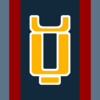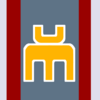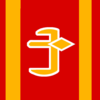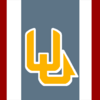User:Troyian
More actions
There are archived versions of this user page, dealing with other subjects.
The Twelve Colonies of Kobol revolve around a single star on elliptical orbits. The planet Canceron is closest to the sun. The planet is followed by a Aquaria, Caprica and Virgon--three planets in Trojan orbit. That means they follow the same orbital path at different points around the central star, separated by roughly the same distance. Two gas giants follow-each in its own elliptical path and each itself orbited by a number of moons. Zeus is the first gas giant. Its moons are Leonis, Picon and Scorpia. The planet Aerelon shares Zeus' orbit, positioned exactly opposite on the other side of the sun. The second gas giant is Hera. Its moons are Gemenon and Libris. The planet Sagittaron orbits opposite of Hera. The planet that follows in the outermost edge of the system is Tauron, which is followed by a third gas giant named Ragnar.
Aerelon

Long ago, Aerelon was called Aries. The world and its people were sturdy and dependable. Aerelon's vast, fertile fields fed eighty percent of the system. Still, Aerelon's people were among the poorest in the Twelve Colonies. They had to import technology and manufactured goods - mostly items they could not make for themselves. They were considered to be somewhat poor hagglers, looking for fairness in all things. Some call this naive, but anyone lucky enough to call an Aerelon friend could rely on that friend for life.
Aerelon's cities were small and unassuming. Few of the buildings were more than a couple of stories high. The Aerelons didn't build what they didn't need, keeping their communities close and compact. This showed in their daily lives. Most Aerelons were born, grew old, and died in the same hundred square kilometers. Some never left the towns of their birth. They woke each day in the same beds, worked each day in the same fields, and ended each night in the same pubs, drinking the same beer. Outsiders saw this life as sad and unfulfilled, but the Aerelons were proud of their simple lives. They did an honest day's work for an honest day's pay.
Given their background, Aerelons have had a pretty easy time acclimating in the Fleet. That, and the fact that a fair chunk of the marines and deck crew grew up with dirty, farm-worn hands. The military was always the easiest way off the farmstead.
Aerelons aren't afraid of work and they're not afraid to face down a Cylon to get the job done.
They are also rather known for playing a mean game of Triad.
Aquaria

Aquaria is just ahead of Caprica in the system's Trojan orbit. Dotted with many small seas, its tribe settled along the coasts and developed a water-oriented culture including a strong sailing tradition. The planet's proximity to Caprica and Virgon made it cheap and easy to trade their two most abundant resources: fish and algae. They also developed highly efficient growing techniques that worked pretty much everywhere. Nearly every botanical ship in the fleet is either owned or operated by Aquarians.
Aquarians are quiet, thinker types. Some call them shifty but more often than not, they just don't have anything to say. Rather than fill the air with noise, they keep to themselves. Aquarians are extremely self-sufficient and ask few questions. They get to the point and rarely bicker. The only time they're really talkative is when they're telling stories. The Aquarians do love their stories. Most of the time, they tell creepy campfire tales about ghosts and the power of the sea. The Aquarians never really pushed inland, leaving a lot of their world untamed, unexplored. Their folklore therefore focused on stories which wondered what was out there, lurking in the darkness of the night.
Watching Aquarians in the Fleet, it seems like they feel the same way about space. "We could find anything out here". It's not unusual to find them just staring out a porthole, watching the stars, dreaming up new stories. Might be why so many entertainers come from Aquaria. Their minds are always wandering. Lots of tortured artists among them too. They might not mind being alone but many don't get along in their own heads either.
Lots of Aquarians are in the service. They don't mind space so much: sea sailing on their home world is far worse. You lose control in space, you drift. You lose control on the sea, you die. Best of all, Aquarians rarely get rattled. Even in the most pitched battles, with the ship bucking and jerking, they just stomp across the deck, never losing their footing.
Its kind of spooky actually...
Canceron

Located closest to the system's sun, Canceron is mostly a barren, hellish pit. The majority of its surface isn't fit for anything. The entire middle was nothing more than a cracked up desert broken up by volcanoes. The Colonial Fleet used this region for flight exercises - bombing and strafing like there was no tomorrow. Hard for people to complain about blowing up useless land. Also meant that the military was close at hand in case the bad half of the population got out of line.
Canceron was home to two groups, one at each pole. The Southers were dour folk who mostly lived in climate controlled subterranean mazes. They were good at selling things. Had to be. When your world only had one export and half of it was automatically sent to the other worlds, you got mighty good at making money off the rest.
The Northers were the troublemakers. At any given time, over 2000 federal prisoners toiled in mines digging tylium. Canceron wasn't the system's only prison. Several high-security penal station were located on other planets, but inmates always had the option to transfer to Canceron. In exchange for enduring the hellhole and mining tylium for their home colonies, inmates earned 'freedom points' towards early release.
Everyone made out. Except the Cancerons, but that's what happens when you're sitting on the majority of a natural resource the government deems "essential to the health of the colonies".
Canceron's where the black market got started. The Canceron penal colony housed all the really motivated inmates, the criminals with vision. On the inside they planned, when they got out, they acted.
Some say the head of the black market in the fleet, a soft-spoken fella by the name of Phelan, spent some time on Canceron. That would explain all his connections, it also explains his less-than-sunny disposition towards the military.
Caprica

Central in the Trojan orbit, Caprica used to be a beautiful blue-green world with the perfect climate. The colony had rolling hills, pleasant lakes, and deep forests. The cities were heavily populated, but it never seemed that way. Glittering silver towers spiked through bustling open air markets and plazas. Parks, rivers, and waterfalls were everywhere. So comfortable were Caprica's cities that people rarely paid attention to the steady lines of vehicles streaking past overhead.
Caprica was also the center of government, education and culture. Its capital of Delphi housed all three branches of government and hosted the biggest corporations and universities in the system. The city had replicas of the Forum, Temple, and Opera House trying to replace the originals left behind on Kobol. The Museum of the Colonies displayed many original artifacts from the lost home world.
Before the nukes fell, it seemed like half the colonists came to Caprica to visit the heart of colonial faith, business and law. Every year, the planet's spaceports grew and its cities expanded. While many visited, only the best and the brightest stayed. You had to be good to survive there. When you did though, life was worth living. Many claim that Capricans grew decadent, but its inhabitants were too comfortable to listen. They stretched out on sandy beaches, sailed clear blue seas, and enjoyed privileged and sheltered lives. Professionally, they raced around, making laws and money, rarely thinking beyond their atmosphere. Many Capricans have a hard time in the Fleet. Their specialized skills don't mean that much anymore and their former status tends to get them into trouble. A few, like Kara Thrace, are exceptions. These people came from the other Caprica, where the colonial military elite made its home. Several of Caprica's spaceports were exclusive to the fleet, and Caprica City's Government Center Plaza housed the Colonial Defense Mainframe and Baltar's Command Navigation Program. You have to wonder though. Most of the Cylons' strategies exploited these resources. Might have been better off for all of us if the military types had stayed on Picon.
Gemenon

Gemenon was the third colony settled, after Tauron and Caprica. The first to arrive were the priests, oracles and others who closely studied the Sacred Scrolls. Others of a religious bent followed. They built shrines and temples by the dozens. The place was so unpleasant, there wasn't much reason to be there.
Gemenon became a place for religious pilgrimage. Visitors bundled up and braved the cold, windswept mountains of this rocky planet to see the original temples and monasteries built by the first colonists. Several natural wonders were exalted as well, including the Faces of the Lords, a series of wind carvings said to resemble the gods. Religious types believed that trips to these sites would awaken and refresh the spirit.
As of the Cylon holocaust, two sects lived in relative tolerance of one another on Gemenon. The fundamentalists believed that every word of the Sacred Scrolls was literally truth. Even the crazy talk. The gods could heal and regularly bestowed visions on their most devout followers. The cycle of time repeated forever. The 13th Tribe was real and founded Earth. Many see the fundamentalists as a little loony - zealots, or worse. It didn't help that they looked at children as property of the gods and imposed the death penalty for abortion, child abuse, and even a failure to provide proper education.
The second religious faction was made up of orthodox theists. Contrary to their name, these folks were the least judgmental of the Gemenese. They used their resources to found the Colonial Cross, a relief foundation that served the Twelve Colonies. They also operated Kobol College, with schools devoted to philosophy, psychology, medicine, administration, civil engineering, and public relations. Their efforts earned them a significant following and great political pull.
Gemenon was one of the poorest colonies, by choice as well as circumstance. There were families with considerable wealth, but most had little more than strong faith. What money came in was from lumbering, metal mining and cloud scooping of useful gas from the nearby gas giant, Hera.
Leonis

In the service, rookies are taught the "Lesson of Leonis", which is two-fold. Leonis teaches that over-enthusiastic pride can destroy. It's also a testament to the power of the colonial arsenal, and what happens when war goes too far. These lessons are quite apparent in the aftermath of the Cylon attack. There's just not many left to learn them anymore.
When the tribes originally settled the Colonies, the followers of Leo fought tooth and nail to claim one of the three habitable moons of the gas giant Zeus. The colonists knew that the planet contained uranium, which was required to make nuclear weapons. They were sure that controlling a primary source of uranium would give them great standing in the colonies. After a hard fight, they won their claim. Early on, their position was very strong. The Leonids were instrumental in founding the colonial military and advancing its weaponry. They built elaborate stations, hoping to become the hub for Fleet operations in the system.
Unfortunately, the uranium ran out within a few centuries. The Leonids continued to fight for their place at the head of the proverbial table but it only got them into trouble with the other colonies. During a particularly bloody civil war, Caprica and the other two moons of Zeus - Picon and Scorpia - bombed Leonis back to the Stone Age.
Leonis was largely subservient to Picon after that. Politically, it was a non-entity. The Quorum of the Twelve was often a Quorum of Eleven with one representative standing in for both colonies. The Leonids became bitter, resentful people. They scraped by working a number of ship-building contracts at gloomy, hollow stations. Some claimed the military continued to grant these contracts out of guilt.
Fact is, things are actually looking up for Leonids nowadays. They're making a comeback in the post-invasion fleet. Many of their people were ground pounders, deck hands, and mercenaries before the attack. Exactly the skills needed now. More and more Leonids are being recognized as heroes, leading the defense against the Cylons.
Libris

Libris was known mostly as the colony that warred the least. Rattled or perhaps disgusted by the flight from Kobol, its people chose a seemingly out of the way moon and interacted little with their brothers and sisters. They shunned most of the colony wars, gaining a reputation for having cool heads. At one point, the colonies tried to formalize this, asking the Librans to mediate looming conflicts. They refused.
Libris had many natural resources but not much of any of them. Its people had many skills, but didn't specialize in anything. Some of the fought. Some of them farmed. Some mined. Over the first several centuries in the system, the planet generated its slow, steady income from many small enterprises. It wasn't until the other colonies realized that Libris was the safest place for their money that the world gained a real name for itself.
The Libran banking system grew quickly. Folks appreciated that their savings wouldn't go up in a puff of ordinance every time a war broke out. Before long, the Librans were one of the wealthiest colonies in the system. All they had to do was take people's money, protect it, and skim off their share.
Several hundred years ago, Libris decided to invest its cubit stockpiles in the one thing they had in abundance: land. They built resorts, casinos, and cruise ships such as the Space Park, a passenger liner now flying with the fleet. This attracted people from every colony and made Libris one of the hottest destinations around.
Librans are an intense bunch. Their financial background demands serious, focused attention, but their entertainment venues let them unwind in style. A Libran rarely does anything halfway, when he's on, nothing can shake him and when he's not, he's almost certainly at a party. Libran parties are legendary. More than once, half a morning's CAP stagger in with no idea where they've been the last twelve hours.
Picon

In the twilight of te Twelve Colonies, Picon was the colonial military hub. Caprica was the center of the politics and the home to the brass. Still, when they needed ships, they called Picon to make them. True, Picon would hire the Leonids to actually build the ships, and people from all over the colonies would staff them, but Picon ran the show.
Picon's military muscle dated back to the civil wars and its bitter rivalries with Leonis and Scorpia. Three moons full of military-minded tribes orbiting the same gas giant - sparks were bound to fly. At first, it looked as if Leonis would have the upper hand, controlling the largest stockpile of uranium. Then, it ran out, leveling the playing field. The fighting heated up then, and it looked like Picon and Leonis would beat each other senseless with Scorpia goading them along. That is, until Scorpia revealed its masterstroke: an alliance between Picon and Caprica.
After that, the fighting was pretty much academic. Leonis was doomed to play the slightest role among the moons of Zeus, and its place in the colonies suffered as well. Picon absorbed much of Leonid culture and many of its people. The only place where the rivalry between Leonis and Picon remained was on the Pyramid court. There, Leonis showed its teeth every season. More often than not, they claimed victory.
Picon thrived. Its alliance with Caprica and Scorpia made it the centerpiece of the colonial military. Ultimately, Picons were happy to leave the politics to others, so long as control of the military stayed with them.
Picon has always emphasized strong leadership and military professionalism. They are excellent Fleet officers, pilots, and marines. That's where they're most comfortable. Having sailed the wide oceans covering most of Picon's surface since the colony's inception, they are no-nonsense, traditional, naval sons and daughters. Picon steadiness and tradition cannot be matched.
Sagittaron

Sagittaron was colonized by a splinter faction of Gemenese fundamentalists who felt that their brothers and sisters didn't embrace the faith enough. They chose a distant planet opposite the gas giant Hera for its remote location and fertile land.
Before the Cylons return, the other colonies often viewed Sagittaron's as uncultured, unwashed heathens and exploited them. They took advantage of them in trade negotiations, keeping them poor. On many occasions, they simply stole from them, or worse. At one time or another, half the other colonies claimed territory on Sagittaron. They destroyed the planet's buildings and some even took its people as slaves.
Naturally, this didn't instill much good will in the Sagittarons, but most of them refused to take action. They just don't make much of a fuss, even when their caustic tempers get the best of them. One of their popular phrases sums it up nicely, 'If you don't have anything nice to say, come sit over here next to me'.
The Sagittarons are a simple people, pacifists by nature, herbalists and farmers by trade. They believe that sloth is the ultimate sin and that work is faith. None of that is too far out there but they're so keyed into 'separateness' that lots of folks dislike them. They withdraw from society but they aren't hermits - they don't shun outsiders but don't have much use for them either. They don't attend school but they aren't stupid - they teach each other skills the rest of the colonies never adopted. They refuse medicine but are not suicidal, they believe that the Lords of Kobol save those who deserve salvation. They reject many technologies that make life easier, viewing shortcuts as sin. Only those who embrace challenges are assured eternal deliverance.
A few Sagittarons are real hard-cases. One of the survivors, Tom Zarek, was the leader of a terrorist group known as SFM. Twenty years ago, he and his followers blew up a government building in protest over the mistreatment of his people. He also wrote an inflammatory book that was virtually banned throughout the colonies. In keeping with their pacifist ways, many Sagittarons speak out against Zarek, but those who support him seem to be growing.
Scorpia

Scorpia is the third moon of Zeus, a gas giant that also hosts Leonis and Picon. It used to be a small, cool world of dense woodlands and exotic plant life. Its population was always low, even for a moon its size, but what they lacked in numbers they made up for in cunning. The Scorpians were shrewd strategists, brokering deals with the right colonies at the right times. Somehow, they always come out ahead even when they double-crossed their allies. An early alliance with the Tauron secured critical military technology that kept them from suffering the same fate as Leonis during the colony wars. More crucial to their survival, however, was their pivotal role in the alliance between Picon and Caprica, which set the balance of power between the moons of Zeus for over a thousand years.
The ancient rivalry between Picon and Leonis was infamous, and it often spilled over into neighboring worlds. Scorpia was closest and in the early days it became the sandbox the bigger kids stomped in. Though Scorpia fought just enough to make a point, it wasn't really interested in a prolonged struggle. Fortunately, it didn't have to be. Through its strong ties with Tauron, Scorpia had influence at the heart of the system, Caprica. Its delegates convinced the colonial government that Leonis was responsible for a few key battles in which Capricans died and suddenly the Leonids were fighting three worlds at once. By the time the dust settled, Scorpia had already reached an arrangement with the other victors to establish the moons of Zeus as the home of the Colonial Fleet. Leonis would build the ships, Scorpia would house them, and Picon would administer the whole. So it remained until the Cylons returned.
Scorpians are often considered cold and calculating, and more than a few are. Still, their innate charisma and sense of humorous irony makes them entertaining and popular. Before the fall of the colonies, the Scorpians' wry wit catapulted many of them into the public eye as celebrity comedians. Their scathing novels and public speakers attracted attention system-wide. Those that stayed out of the limelight were - and are - no less influential.
Tauron

Tauron is the most distant colony from the system's sun and the landing place of the Galleon, the ship that brought the tribes from Kobol. The Taurons are extremely proud of their standing as the first among the Twelve Colonies. In the early days, they flaunted that position and took credit for other colonies' successes. After all, no one would be there if not for them. The Taurons' superiority eventually wore thin, and the screaming got really loud when the Taurons challenged the Gemenese interpretation of the Sacred Scrolls. Fighting started immediately after.
Despite instigating much of the tension in the early colony years, the Taurons eventually withdrew from the fighting. They preferred to further the technology aboard the Galleon. The Taurons claim to have built the Galleon for the Lords of Kobol. No one challenged them as it was all ancient history, and that left the Taurons in complete control of the most advanced science in the system.
The Taurons made good use of the resource, developing much of the new machinery used throughout the colonies. They amassed huge fortunes and heavily influenced the course of scientific development. Over the centuries, though, the Taurons pulled away from the peoples of the other worlds. Their reverence for technology was unnerving and some wondered privately whether the Tauron inventors were more devoted to their creations than to the gods. Maybe there was some truth to that. They did create the silica strands used in Cylon brains.
Tauron is a harsh, frigid world and its people reflect this. They're born of brawny stock and tend to be tall and muscular, thick in body and mind. They're often called stubborn and sometimes insubordinate. They can argue just to argue and rarely give up, even when they're wrong.
Virgon

Virgon is the last of the three planets in the Trojan orbit. A mid-sized jungle world, it had a few concentrated cities, a subtle reputation, and a lot of big ideas. Its people were known for their most frivolous pursuit: Fashion.
Many of the colonies celebrated actors, models, and public speakers were Virgons. Every world looked to Virgon for each season's trends, even in Caprica City. Virgons set the style.
Behind the glitz and the glamour, Virgons controlled or influenced far more than anyone suspected. They were said to have 'the eye', a sixth sense for opportunities, personalities, and motives. This wasn't some sacred gift. The Virgons were religious, but no fiercely. Many oracles came from Virgon, but so did many business moguls, city builders, artists, and soldiers. They claimed it was just healthy, sensible ambition. Have faith in yourself and your deeds, and the gods will provide for you.
Whatever the reason, Virgons were everywhere. Mostly out of the spotlight, their art graced small galleries on Caprica, their contracts crossed moderately influential desks on Picon and Scorpia, and their money filled respectably sized coffers on Libris. Virgons held some fo the most underrated positions in the colonial military, often as gunners due to their keen vision and reflexes.
Outside fashion, Virgons' reputation is one of excellence without notoriety. Self-effacing, and respectful, most Virgons choose accomplishment over fanfare any day of the week.
